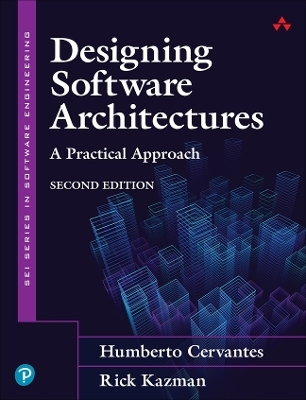
Designing Software Architectures
Addison Wesley (Verlag)
978-0-13-810802-1 (ISBN)
Designing Software Architectures, 2nd Edition, provides a practical, step-by-step methodology for architecture design that any professional software engineer can use, with structured methods supported by reusable chunks of design knowledge and rich case studies that demonstrate how to use the methods.
The Attribute-Driven Design method may not have changed since this book's first printing, but almost everything else about the industry has. In this newly updated edition, you will find new chapters on supporting business agility through API-centric design, deployability, cloud-based solutions, and technical debt in design.
Humberto Cervantes and Rick Kazman illuminate best practices for how architects should design complex systems so you can make design decisions in systematic, repeatable, and cost-effective ways. This book will help you become a better, more confident designer who can create high-quality architectures with ease.
The new edition includes:
A clear explanation of the Attribute-Driven Design method
New chapters focused on the technical environments and contexts of contemporary design
Two new case studies on The Hotel Pricing System and Digital Twin Platform
Coverage of current architecture topics like cloud computing, DevOps, and large-scale systems
Methods to make architecture design agile and achievable
Register your product at informit.com/register for convenient access to downloads, updates, and/or corrections as they become available.
Humberto Cervantes is a professor at Universidad Autónoma Metropolitana Iztapalapa in Mexico City. His primary research interest is software architecture design process tool development methods. He holds the Software Architecture Professional and ATAM Evaluator certificates from the SEI. Rick Kazman is the Danny and Elsa Lui Distinguished Professor of Information Technology Management at the University of Hawaii. He was involved in creating the ATAM (Architecture Tradeoff Analysis Method) and the Titan and DV8 tools for architecture analysis.
Preface xi
Acknowledgments xiii
About the Authors xv
CHAPTER 1: Introduction 1
1.1 Motivations 1
1.2 Software Architecture 2
1.3 The Role of the Architect 6
1.4 A Brief History of ADD 7
1.5 Summary 8
1.6 Further Reading 8
1.7 Discussion Questions 9
CHAPTER 2: Architectural Design 11
2.1 Design in General 11
2.2 Design in Software Architecture 12
2.3 Why Is Architectural Design So Important? 16
2.4 Architectural Drivers 17
2.5 Summary 26
2.6 Further Reading 26
2.7 Discussion Questions 27
CHAPTER 3: Making Design Decisions 29
3.1 Making Design Decisions 29
3.2 Design Concepts: The Building Blocks for Creating Structures 32
3.3 Design Concepts to Support Performance 39
3.4 Design Concepts to Support Availability 41
3.5 Design Concepts to Support Modifiability 46
3.6 Design Concepts to Support Security 49
3.7 Design Concepts to Support Integrability 53
3.8 Summary 57
3.9 Further Reading 57
3.10 Discussion Questions 58
CHAPTER 4: The Architecture Design Process 59
4.1 The Need for a Principled Method 59
4.2 Attribute-Driven Design 3.0 60
4.3 Applying ADD to Different System Contexts 66
4.4 Identifying and Selecting Design Concepts 70
4.5 Producing Structures 74
4.6 Defining Interfaces 77
4.7 Creating Preliminary Documentation During Design 81
4.8 Tracking Design Progress 85
4.9 Summary 87
4.10 Further Reading 88
4.11 Discussion Questions 89
CHAPTER 5: API-centric Design 91
5.1 Business Agility 91
5.2 API-centric Design 93
5.3 API-centric Design and ADD 107
5.4 Summary 110
5.5 Further Reading 110
5.6 Discussion Questions 111
CHAPTER 6: Designing for Deployability 113
6.1 Deployability Principles and Architectural Design 113
6.2 Design Decisions to Support Deployability 119
6.3 Deployability and ADD 128
6.4 Summary 129
6.5 Further Reading 130
6.6 Discussion Questions 130
CHAPTER 7: Designing Cloud-Based Solutions 133
7.1 Introduction to the Cloud 133
7.2 Drivers and the Cloud 136
7.3 Cloud-Based Design Concepts 139
7.4 ADD in the Design of Cloud-Based Solutions 147
7.5 Summary 148
7.6 Further Reading 148
7.7 Discussion Questions 149
CHAPTER 8: Case Study: Hotel Pricing System 151
8.1 Business Case 151
8.2 System Requirements 153
8.3 Development and Operations Requirements 1 56
8.4 The Software Design Process 158
8.5 Summary 188
8.6 Further Reading 189
8.7 Discussion Questions 189
CHAPTER 9: Case Study: Digital Twin Platform 191
9.1 Business Case 192
9.2 System Requirements 193
9.3 The Design Process 195
9.4 Summary 223
9.5 Further Reading 224
9.6 Discussion Questions 225
CHAPTER 10: Technical Debt in Architectural Design 227
10.1 Technical Debt 227
10.2 The Roots of Technical Debt in Design 228
10.3 Refactoring and Redesign 231
10.4 Technical Debt and ADD 233
10.5 Summary 235
10.6 Further Reading 236
10.7 Discussion Questions 237
CHAPTER 11: Analysis in the Design Process 239
11.1 Analysis and Design 239
11.2 Why Analyze? 242
11.3 Analysis Techniques 243
11.4 Tactics-Based Analysis 244
11.5 Reflective Questions 246
11.6 Scenario-Based Design Reviews 247
11.7 Summary 250
11.8 Further Reading 251
11.9 Discussion Questions 251
CHAPTER 12: The Architecture Design Process in the Organization 253
12.1 Architecture Design and the Development Life Cycle 253
12.2 Architecture Design and the Organization 263
12.3 Summary 268
12.4 Further Reading 269
12.5 Discussion Questions 270
CHAPTER 13: Final Thoughts 273
13.1 On the Need for Methods 273
13.2 Future Directions 275
13.3 Next Steps 276
13.4 Further Reading 277
13.5 Discussion Questions 277
Appendix Tactics-Based Questionnaires 279
Index 301
| Erscheinungsdatum | 13.06.2024 |
|---|---|
| Reihe/Serie | SEI Series in Software Engineering |
| Verlagsort | Boston |
| Sprache | englisch |
| Maße | 180 x 232 mm |
| Gewicht | 550 g |
| Themenwelt | Mathematik / Informatik ► Informatik ► Theorie / Studium |
| ISBN-10 | 0-13-810802-1 / 0138108021 |
| ISBN-13 | 978-0-13-810802-1 / 9780138108021 |
| Zustand | Neuware |
| Informationen gemäß Produktsicherheitsverordnung (GPSR) | |
| Haben Sie eine Frage zum Produkt? |
aus dem Bereich


